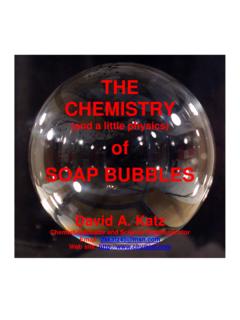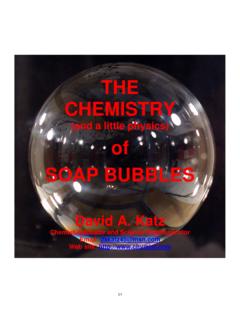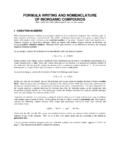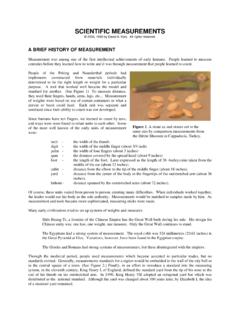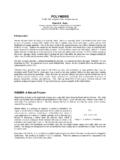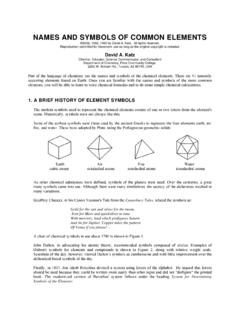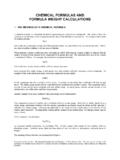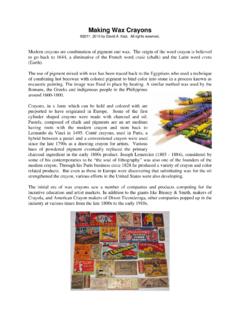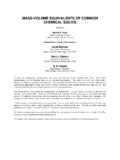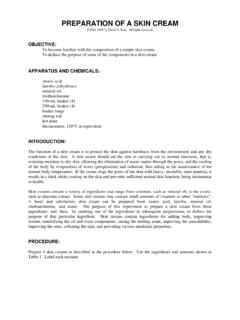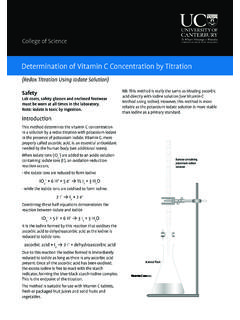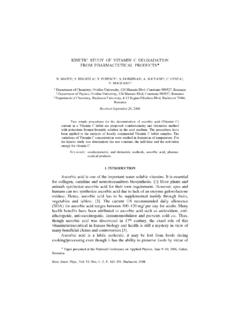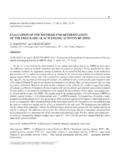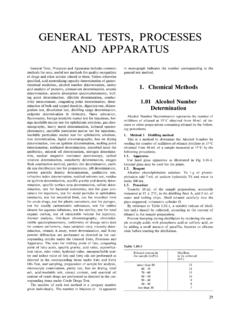Transcription of Determination of Vitamin C in Foods - chymist.com
1 1 Determination of Vitamin C in Foods 2013 by David A. Katz. Al rights reserved. Object The object of this experiment is to measure the amount of ascorbic acid in common Foods using an oxidation reduction reaction. Introduction Vitamin C, has the chemical name ascorbic acid. It is a water soluble Vitamin . Although it is important for good health, humans do not have the ability to make their own Vitamin C and must obtain it through diet or take it in Vitamin supplements. Citrus fruits, potatoes and some green vegetables are known to be good sources of Vitamin C.
2 (See Table 1) Plants synthesize the compound for the growth, development, and protection of the plant. The exact pathway for its synthesis is not well understood. Plant source Amount of Vitamin C (mg / 100g) Plant source Amount of Vitamin C (mg / 100g) Rose hip 426 Spinach 30 Red pepper 190 Potato 20 Parsley 130 Green Beans 16 Broccoli 90 Tomato 10 Brussels sprouts 80 Watermelon 10 Elderberry 60 Banana 9 Strawberry 60 Carrot 9 Orange 50 Apple 6 cantaloupe 40 Lettuce 4 grapefruit 30 Raisin 2 Table 1.
3 Amount of Vitamin C in Various Plants Vitamin C is notoriously easy to destroy. Orange juice may lose half of its Vitamin C in a week in the refrigerator, but cut fruit may lose much less after 6 days (Some examples: mango, strawberry, and watermelon: less than 5%, Pineapple: 10%, Kiwi: 12%, and Cantaloupe: 25%, after 6 days). Cooking also destroys Vitamin C. The US Department of Agriculture reports the following Vitamin C levels: Amount of Vitamin C, mg/100g Vegetable Raw Frozen Frozen then boiled Green beans Broccoli Note: Freezing fresh vegetables requires blanching, , boiling for a short period to stop enzyme actions in the plant.
4 Some cooks had a practice of adding sodium bicarbonate, NaHCO3, to vegetables to maintain a bright green color. That practice essentially destroys the Vitamin C in the vegetables. 2 Vitamin C is required for the synthesis of collagen, an important structural component of blood vessels, tendons, ligaments and bone. It also is important in the synthesis of the neurotransmitter norepinephrine, which is critical to brain function and can affect mood. Vitamin C is also a highly effective antioxidant.
5 In small amounts Vitamin C can protect indispensable molecules in the body, such as proteins, lipids (fats), carbohydrates, and nucleic acids (DNA and RNA), from damage by free radicals and reactive oxygen species that can be generated during normal metabolism as well as through exposure to toxins and pollutants. It has been recommended that Vitamin C, taken in large quantities on a daily basis, may prevent the common cold. Some recommended dietary allowances for Vitamin C are listed in Table 2.
6 Age Male Female Pregnancy Lactation 0 6 months 40 mg* 40 mg* 7 12 months 50 mg* 50 mg* 1 3 years 15 mg 15 mg 4 8 years 25 mg 25 mg 9 13 years 45 mg 45 mg 14 18 years 75 mg 65 mg 80 mg 115 mg 19+ years 90 mg 75 mg 85 mg 120 mg Smokers Individuals who smoke require 35 mg/day more Vitamin C than nonsmokers. Table 2. Recommended Dietary Allowances (RDAs) for Vitamin C Ascorbic acid is the chemical name for Vitamin C.
7 As the name indicates Vitamin C is an acid. Therefore, a base such as sodium hydroxide can neutralize it. Ascorbic acid is also easily oxidized. Both of these reactions can be used for quantitative analysis of the compound. Figure 1. The structure of ascorbic acid, C6H8H6 (MW = g/mol) In this experiment, you are performing an oxidation-reduction titration. You will first determine the concentration of the iodine solution by titrating a solution of ascorbic acid.
8 Next, you will titrate fruit juices or a fruit or vegetable extract. Ascorbic acid reacts with iodine through the following reaction: C6H8O6 + I2 C6H6O6 + 2 I- + 2 H+ 3 The equivalence point of the titration will be determined using a starch indicator. Molecular iodine combines with starch to make a dark blue complex. In the titration reaction, molecular iodine is added in the form of the iodine solution. In the presence of ascorbic acid, the iodine is reduced to colorless iodide ion which does not react with starch to make a colored complex.
9 When all of the ascorbic acid has been titrated, any additional iodine added, present in the solution as molecular iodine, will combine with the starch to make the solution blue. The appearance of the blue solution will signal the equivalence point. As with the acid-base titration, the iodine solution must be standardized against a known solution of ascorbic acid, which you will prepare from the solid. Safety Goggles or safety glasses must be worn at all times in the laboratory.
10 The iodine solution is an irritant and will stain the skin and clothing. The solution does give off a small amount of iodine vapors. Iodine vapors are toxic by inhalation. Work in a well ventilated area. Keep the iodine solution covered. Disposal Dispose of all solutions in the waste containers provided. Materials Needed Ascorbic Acid Iodine Solution 2% Starch solution (indicator) 125 ml Erlenmeyer flasks Buret Magnetic stirrer with stir bar Small funnel for filling buret Blender Knife Small cutting board (wood or plastic) Cheesecloth Funnel Scissors Optional: gloves Experimental Procedure Standardization of the iodine solution You will use a solution of ascorbic acid to standardize the iodine solution.
